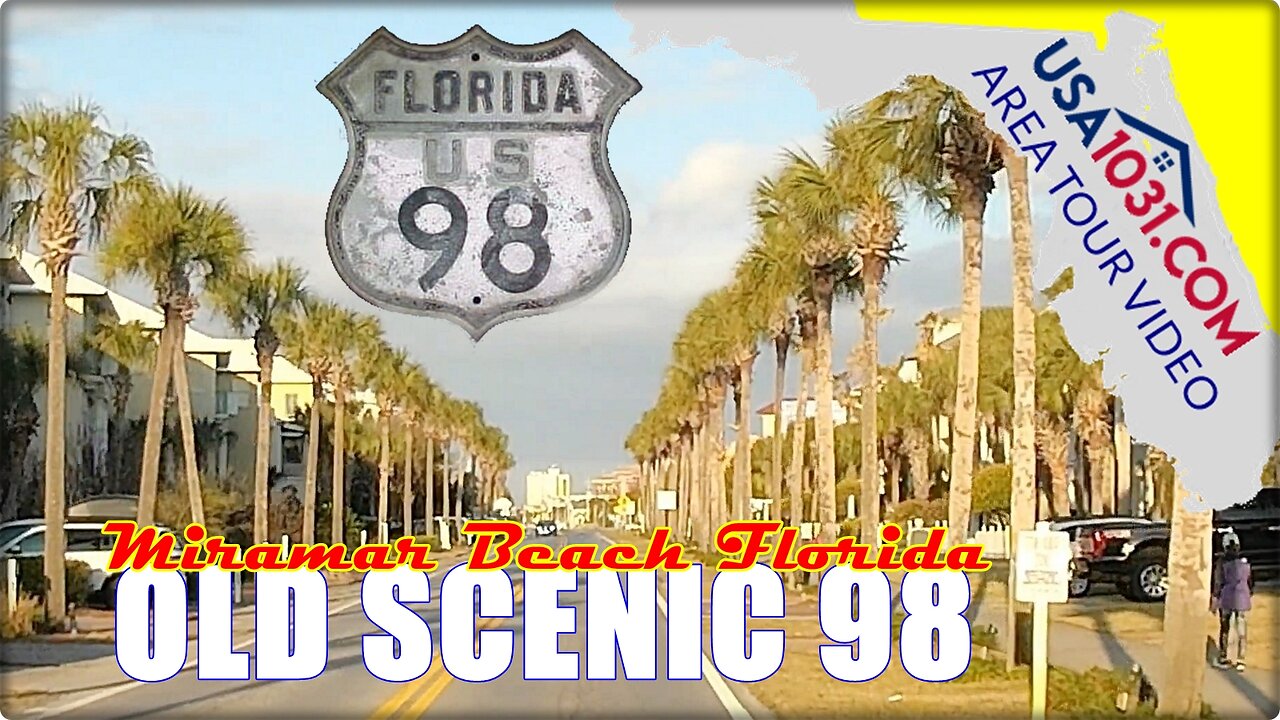Premium Only Content

Old Scenic 98 Miramar Beach Floirida
The Old Scenic Highway 98 in Miramar Beach, Florida is a section of the original US Highway 98 that runs along the Gulf of Mexico. This stretch of road is known for its scenic beauty and historic charm, and it has a rich history dating back over a century. This video is provided by usa1031.com
In the early 1900s, the area around Miramar Beach was mostly undeveloped, with a few small fishing villages scattered along the coast. However, with the advent of the automobile and the construction of the first bridges across the bay, the region began to attract more visitors. As a result, the state of Florida began to pave the highway along the coast, including the section that would later become known as Old Scenic Highway 98.
By the 1920s, the area had become a popular tourist destination, with hotels and vacation homes springing up along the beach. In the years that followed, the highway continued to be improved and expanded to accommodate the growing number of visitors.
In the mid-20th century, the construction of Interstate 10 and other highways led to a decline in the use of the Old Scenic Highway 98, as visitors increasingly opted for faster, more direct routes to their destinations. However, in recent years, there has been a renewed interest in the historic highway, with efforts to preserve its unique character and promote it as a scenic byway and tourist attraction.
Today, visitors can still drive along Old Scenic Highway 98 in Miramar Beach and enjoy its sweeping views of the Gulf of Mexico, as well as its historic landmarks, such as the iconic Sandestin Golf and Beach Resort, which was built in the 1970s.
The Old Scenic Highway 98 in Miramar Beach, Florida is a section of the original US Highway 98 that runs along the Gulf of Mexico. This stretch of road is known for its scenic beauty and historic charm, and it has a rich history dating back over a century.
In the early 1900s, the area around Miramar Beach was mostly undeveloped, with a few small fishing villages scattered along the coast. However, with the advent of the automobile and the construction of the first bridges across the bay, the region began to attract more visitors. As a result, the state of Florida began to pave the highway along the coast, including the section that would later become known as Old Scenic Highway 98.
By the 1920s, the area had become a popular tourist destination, with hotels and vacation homes springing up along the beach. In the years that followed, the highway continued to be improved and expanded to accommodate the growing number of visitors.
In the mid-20th century, the construction of Interstate 10 and other highways led to a decline in the use of the Old Scenic Highway 98, as visitors increasingly opted for faster, more direct routes to their destinations. However, in recent years, there has been a renewed interest in the historic highway, with efforts to preserve its unique character and promote it as a scenic byway and tourist attraction.
Today, visitors can still drive along Old Scenic Highway 98 in Miramar Beach and enjoy its sweeping views of the Gulf of Mexico, as well as its historic landmarks, such as the iconic Sandestin Golf and Beach Resort, which was built in the 1970s.
Miramar Beach is a beautiful coastal community located in the northwest region of Florida's panhandle. Before European settlement, the area that is now Miramar Beach was inhabited by the Choctaw tribe, who were displaced by European settlers in the early 19th century.
In the late 19th and early 20th centuries, the area was primarily used for timber harvesting, fishing, and farming. It wasn't until the 1930s that the area began to see significant development, with the construction of the first hotels and tourist accommodations.
During World War II, the area served as a training ground for soldiers, with Camp Walton being established just to the east of what is now Miramar Beach. The military presence helped to further develop the area's infrastructure, with new roads and bridges being constructed to accommodate the increased traffic.
After the war, the area experienced a boom in tourism, with the construction of new hotels, restaurants, and attractions. In the 1980s and 1990s, the area experienced further development with the construction of new condominiums and vacation homes.
Today, Miramar Beach is a popular tourist destination, known for its beautiful white-sand beaches, emerald-green waters, and world-class golf courses. It is also home to a variety of shops, restaurants, and entertainment options, making it a popular vacation spot for families and couples alike.
The sand in Northwest Florida is known for its white color due to its composition of mostly pure quartz crystal. The quartz crystals come from the Appalachian Mountains and are carried downstream by rivers until they reach the Gulf of Mexico. Over time, the crystals are broken down into small pieces by the action of waves and tides, resulting in fine, white sand that is characteristic of the beaches in the area. Another factor that contributes to the whiteness of the sand is the lack of organic material and other impurities. The sand in Northwest Florida is relatively pure, which means that it reflects more light and appears brighter and whiter than sand that contains more impurities. Overall, the combination of pure quartz crystal and lack of impurities in the sand, as well as the constant weathering of the crystals by the waves and tides, contribute to the white color that makes the beaches of Northwest Florida so distinctive and beautiful.
Our network of 1031 Exchange professionals is available to assist you with your 1031 Exchange anywhere in the United State. We sell and identify suitable exchange properties. Please visit us at http://usa1031.com/florida/old-scenic-98-miramar-beach-florida.html
-
 49:18
49:18
PMG
1 day ago $2.86 earned"Biden Regime Trying to Trigger WW III Before Trump Term Begins, and Ballots Still Being Counted?"
35.3K2 -
 1:24:27
1:24:27
Flyover Conservatives
15 hours agoWhile Trump Claimed Victory, Guess What They Were Doing Behind the Scenes... - Mel K | FOC Show
42.9K2 -
 1:33:53
1:33:53
Adam Does Movies
9 hours ago $4.11 earnedIs Dwayne Johnson A Bankable Star Anymore? + TONS Of New Movie Trailers - LIVE!
32.2K4 -
 3:00:44
3:00:44
Tate Speech by Andrew Tate
18 hours agoEMERGENCY MEETING EPISODE 91 - CASE DISMISSED
391K330 -
 2:22:54
2:22:54
WeAreChange
8 hours agoLiberal Media COLLAPSING! Begging For Forgiveness!
84.8K40 -
 17:25
17:25
TimcastIRL
16 hours agoDOJ, FBI Officials Are LAWYERING UP, FEARING Prosecutions From Matt Gaetz & Trump
79.8K165 -
 58:58
58:58
The StoneZONE with Roger Stone
9 hours agoAmerica’s Political Realignment – Democrat Gov. Rod Blagojevich Joins The StoneZONE w/ Roger Stone
47.5K6 -
 13:50
13:50
Tundra Tactical
9 hours ago $2.10 earnedILLINOIS Assault Weapon Ban OVERTURNED!!! (for now)
34.3K3 -
 54:36
54:36
LFA TV
1 day agoTrump Dance Syndrome | Trumpet Daily 11.19.24 7PM EST
58.9K9 -
 1:31:38
1:31:38
Redacted News
10 hours agoBREAKING! NATO ATTACKS RUSSIA & DEFIES TRUMP'S CALL FOR PEACE, PUTIN NUCLEAR RESPONSE | REDACTED
190K413